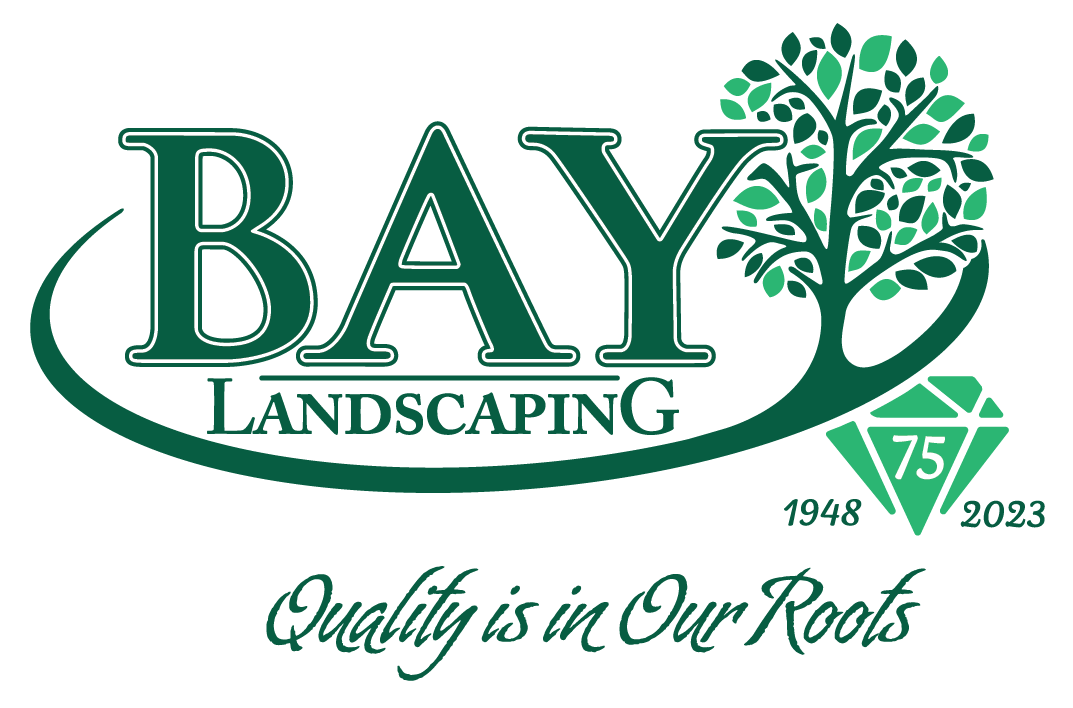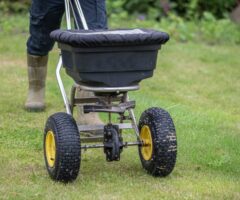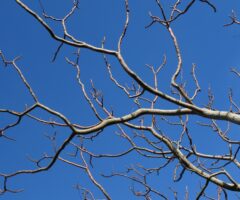Summers in Mid-Michigan can be tough on lawns, landscape plants, and trees. Average high temperatures in summer hover in the low 80’s and we get less rain (particularly in July), leaving plants stressed from both heat and lack of water.
But that doesn’t mean your landscape can’t look terrific all season! With a few simple tweaks to your landscape maintenance tasks, you can keep lawns green, flowers blooming, and shrubs and trees providing cooling shade. The tips below will help your landscape flourish through the summer.
Summer Landscape Tips

#1 – Water Correctly
Summer watering doesn’t mean you need to drain your well or rack up a huge water bill. Overwatering is as bad as underwatering; both can kill your plants. So instead of drenching your landscape with unnecessary water, irrigate the smart way.
- Understand the output of your irrigation system (if you have one) or sprinklers. Here’s how to measure how much water it emits.
- For lawns, aim for one inch of water per week (including rain, if we get any).
- Containers and hanging baskets need to be watered more often, sometimes even twice a day if they’re in direct sun.
- Check often to see if they need water. Simply stick your finger in the soil up to the 2nd If it’s dry, the plant needs water. Or, if it’s a small pot or hanging basket, lift it up. If it’s light, add water.
- During a heatwave, try to move potted plants to a shady, cooler spot.
- We recommend using self-watering AquaPots to cut down on watering needs.
- Water early in the morning to give plants time to take up moisture before temperatures really heat up.
- Water plants deeply. You want water to reach the plants’ roots, which are usually at least to 6 inches down.
- Watch for wilting. Plants are the best indicator of when they need water—when they wilt, it’s a sign that they need water. But do try to water before they start to droop!
- Know your soil type. Plants in sandy soil need more frequent watering than those in clay soil.
- Use drip irrigation systems or soaker hoses instead of sprinklers to water garden beds and shrubs. It’s far more efficient because the water gets right to the plant’s roots and doesn’t evaporate as easily. Plus, it prevents susceptible plants, like phlox and roses, from developing foliar fungal diseases.
#2 – Cover Bare Soil with Organic Mulch
A layer of mulch is invaluable in combatting summer heat. Organic mulch:
- slows down evaporation,
- lowers soil temperature,
- suppresses weed growth (weeds compete with your plants for water), and
- looks great!
Add a 2 to 3 inch layer of mulch around plants where you can see bare soil. You can even use it in containers. Just be sure to keep it well away from plant stems and tree trunks to prevent moisture buildup and rot.
We sell high quality wood and bark mulch by the cubic yard (for pickup or delivery) or bagged.
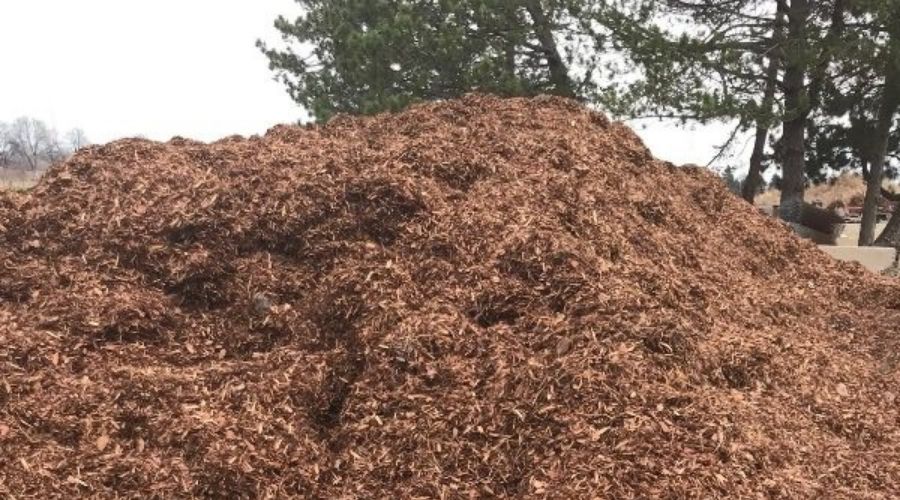
#3 –Mow the Lawn High
Many homeowners mow their lawns too short, making them more susceptible to drought stress and heat damage.
The recommended lawn height for the types of turfgrass we have in mid-Michigan is between 3 and 5.5 inches. That’s much higher than most people mow their lawns!
Cutting your grass higher reduces stress and helps green the lawn without needing extra fertilizer. Taller grass shades the soil, which keeps vulnerable grassroots cooler, preserves soil moisture, and shades out weeds so there’s less need for herbicides.
We also recommend that you leave the grass clippings on the lawn. They add nitrogen, organic matter, and moisture to the soil. Just one season of grass clippings is equal to one fertilizer application. Every time you mow, you’re improving the soil and fertilizing the lawn!
>> 7 Lawnmowing Tips for a Perfect Mid-Michigan Lawn
#4 – Check for Pests & Disease
Stressed plants are more vulnerable to attack by harmful insects and diseases. Walk around your garden regularly (perhaps with your morning coffee in hand) and look for signs of potential problems. Common signs and symptoms of insect or disease issues include:
- blotches or spots on leaves
- brown, crispy leaf edges (particularly if you know the plant has received enough water)
- rotting or spotted fruit (apples, peaches, plums, etc.)
- fuzzy white or grey growth on leaves
- yellowing, curling, or speckled leaves
- holes or ragged/chewed edges on leaves
- dying needles on conifers
- browning leaves and premature defoliation
- dying branch ends
- cankers or oozing sores on branches and tree trunks
- silk webs, threads, or “tents” on stems or branches
- small holes in tree bark (especially on ash trees)
- trees or shrubs suddenly losing leaves
- strange bumps on stems and small branches
- a sticky substance (and maybe black mold) on leaves or under the plant
If you see anything that doesn’t look right, or if you have any questions about your plants’ health, please give us a call. Our experienced horticulturists and arborists will be happy to inspect your plants, diagnose the issue, and recommend treatment if one is needed. https://baylandscaping.net/about#team
#5 – Deadhead Flowering Annuals
Annuals are plants that complete their lifecycle, from seed to death, in one growing season. Their natural tendency is to produce as many seeds as possible to ensure the next generation of plants. Once they start producing seeds, they put all of their energy into developing those seeds to maturity, rather than “wasting” energy producing more flowers.
Since we usually grow flowering annuals for the blossoms, we need to “trick” the plant into continuing to flower instead of setting seeds. You can do that by removing spent flowers (“deadheading”) before they go to seed. This is a simple process – just pick or cut off the dying blossoms every few days and the plant will keep flowering.
#6 – Keep Up with Harvesting
If you grow fruit, vegetables, or herbs, harvest them as soon as they’re ripe (or even just before). Over-ripe or rotting fruit and vegetables attract all kinds of pests (squirrels and raccoons love them!) and can spread fungal diseases to nearby plants. Unharvested vegetables can eventually become inedible. If you’ve ever discovered an enormous zucchini hidden under a tangle of leaves, you know how mealy, tough, and seed-filled they can get! And herbs that aren’t regularly cut back will stop growing and go to seed.
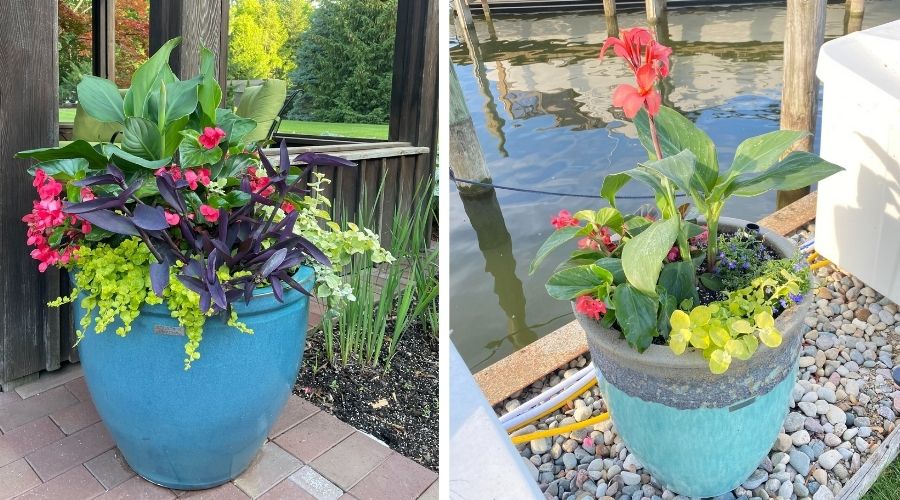
#7 – Add Some Color with Heat-Loving Annuals
You probably have a variety of shrubs and perennials in your landscape, including flowering shrubs (here are our top recommendations). But you may notice that the blooms peter out by mid-summer, leaving areas in the landscape without any bright color. If that’s the case, you can fill in those gaps with summer-blooming annuals planted either in the ground or in pots.
Below are some colorful, easy-care annuals that do well in Mid-Michigan gardens.
- Alyssum
- Bacopa
- Canna
- Coleus
- Geranium
- Petunia and Million Bells (Calibrachoa)
- Sunpatien Impatiens
- Sweet Potato Vine
- Verbena
- Zinnia
All of these annuals (plus many other types of plants) grow extremely well in self-watering AquaPots. AquaPots don’t need to be watered nearly as often as other containers and have the added benefit of coming in a range of styles that add a beautiful pop of color to your yard.
#8 – Continue Regular Landscape Maintenance
Although growth slows down in summer, regular maintenance is still important. To keep your landscape healthy and looking its best, keep on top of:
- weeding (before they go to seed!)
- edging to keep planting beds looking neat
- clearing debris and algae from water features
- controlling vegetation along fence lines, sidewalks, driveways, patios, etc. to provide clearance and a clear line of sight
- removing invasive or noxious plants
If you’re not up to gardening in the summer heat, hire a landscape maintenance company to do the work for you. Bay Landscaping offers a full range of landscape maintenance and horticultural services that will give you a yard you can be proud of.
>> Landscape Maintenance Services

#9 – Add Some Shade
Stressed and struggling plants will appreciate some shade, especially from the blazing hot afternoon sun. If you can’t move the plants to shade, bring the shade to them!
Temporary shade can be as simple as a strategically placed lawn chair, a lattice panel propped over the plants, or even an umbrella. During a heat wave, this could make the difference for your more tender plants between survival and being burned to a crisp.
To shade larger areas or create more permanent sun protection, consider using shade cloth. It will bring down the temperature beneath it by 10 degrees or more.
You’ll need to create some sort of frame to hold the cloth over the plants. PVC piping, chicken wire cylinders, cattle fencing, and spare lengths of lumber are all easy options that can be used to support shade cloth. Just don’t lay the shade cloth directly on your plants; it won’t provide as much sun protection and will reduce air circulation (which could encourage diseases).
#10 – Avoid Stressing Plants
Don’t do anything during the summer that will further stress a plant. Avoid dividing or transplanting, major pruning, or fertilizing with a high nitrogen fertilizer.
It’s OK to prune off diseased or dead parts on a plant, shrub, or tree, but don’t go overboard. Leaves help cool the plant and shade the ground around it. And major pruning forces new growth which takes up the energy reserves the plant needs to survive the summer heat.
Take Care of Yourself
Finally, don’t forget to take care of yourself too! Heat exposure can quickly lead to heat exhaustion, heat stroke, and even death. We always encourage people to spend time in their garden, but please do it sensibly.
- Keep hydrated. Carry a water bottle—and use it! You need water as much as your plants do.
- If you plan to work in the garden, do it in the morning before the hottest part of the day.
- Wear a hat and lather on the sunscreen when outside.
Questions About Summer Landscape Care?
If you have questions about taking care of your lawn or landscape, just ask the Bay Landscaping Experts! We’ll answer your question online or, if you prefer, we can schedule an appointment to inspect your property. You can also visit us at our nursery in Essexville, MI where our friendly staff will be happy to help you.
